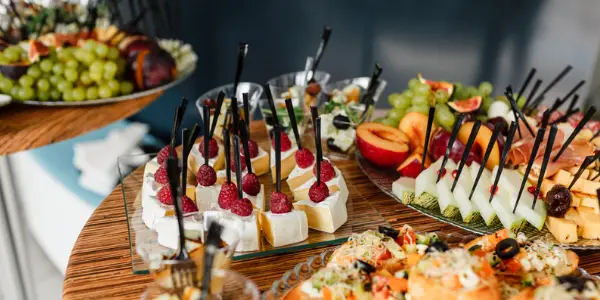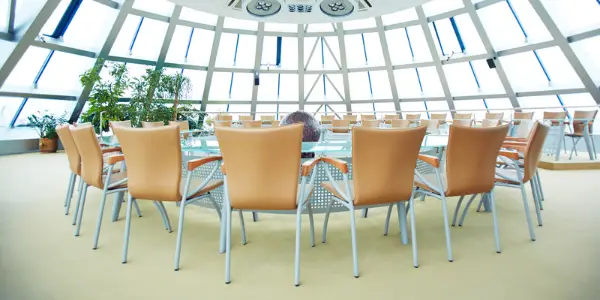Whether you’ve chosen to lead a retreat, been volunteered by your boss, or even if retreat planning is a regular part of your job, organizing a leadership retreat can be daunting.
There’s so much to think about – who, what, when, where, and the biggest of all – how will you get it all done?
Don’t worry – we’ve created a list of leadership retreat ideas and the most important things to consider in your planning.
The best thing to do is to start early, form a team to help (if possible), and work down the list below. Chunk the work into small steps, and make consistent progress toward your goal.
You’ve got this – here we go!

Leadership Retreat Ideas
Leadership Retreat Ideas: Meeting Foundations
Develop a clear purpose
Any well-executed meeting should have a clear written objective. This objective will be used throughout planning for making decisions, developing communications, and determining attendees.
In her best-selling book The Art of Gathering, Priya Parker argues that the best thing to do when organizing a gathering is to think less about the what and more about the why.
The obvious purpose is to host a leadership retreat. According to Parker, that needs to be more specific. Ask “why?” several times until you understand the meaning of the retreat.
Harvard Business Review’s Leadership Summits That Work suggests starting with two questions:
- What do you want the outcome of the meeting to be from the perspective of the attendees?
- What do you want them to say when their team asks, “What happened at the big meeting?’”
Do you intend to do long-range strategic planning, build trust among a leadership team, drive a company transformation, solve a specific problem, or integrate leadership teams after an acquisition?
Get as specific and as straightforward as possible.
Develop a planning team
If you have the luxury of having a team around you, set that up early in the planning. Try to find people with different skills. Helpful skills include (but are certainly not limited to) financial, event planning, event facilitation, public relations, communications, graphic design, and audio/visual.

Identify roles and responsibilities
With a planning team in place, determine who will play what role, what responsibility they have, how decisions will be made, and how to communicate within the group.
The event sponsor or executive in charge should be recognized as the ultimate decision-maker.
Each team member should know and agree on what they are responsible for, how to escalate issues, and how to interact with other team members.
Document communication plans with the team
Communication among the planning team should be robust and crystal clear to all members.
Will you have recurring team meetings? What other methods will you communicate – will you include periodic email updates or send information through a project management tool?
If you need virtual communication tools, check out this comprehensive post from Science of People.
Gain approval on a budget (or range of spend)
So many of your retreat decisions depend on how much money you have to spend.
You can run a fantastic event for nearly any dollar amount, but you’ll need to get more creative with less money.
Regardless, setting a budget and getting approval to spend is an essential early step that informs many other decisions.
Determine the attendee list
With your purpose and budget determined, developing an attendee list is next.
The attendee list should be manageable; ideally, only the people needed to reach the goals for the meeting should be included.
Keep these meeting sizes in mind (From The Art of Gathering by Priya Parker):
- Group size 12 – 15: This is small enough to build trust and intimacy, make decisions, and still have diverse opinions.
- Group size 30: This group size will be full of energy and buzz (it may feel more like a party). This isn’t a good size for making decisions, but it could be used for sharing information and gathering feedback.
- Group size 100-150: This will feel more like a conference and requires more sophisticated planning, including breakout sessions.
Avoid the urge to invite people to be polite or not hurt feelings. Only the people needed to achieve the meeting purpose should be invited.
Lockdown time and dates
It’s tempting to plan a week-long retreat, but the truth is that people typically only have the energy for three days or less.
Setting a shorter number of days will force a focused agenda, ultimately making your meeting more successful.
Considering your attendee list, find at least one block of days where everyone is available (including travel time).
Send all attendees a save-the-date notice as soon as the dates are identified. Ensure everyone knows not to book important meetings, vacations, or anything else in your time block!
Find and book a venue
Choosing the right venue can make or break the event.
When it comes to event planning, the early bird gets the worm, so book a minimum of 6-8 months in advance if you can.
Note: Do not pick an onsite location where you work. It will be entirely too distracting. Select another place in the same city if your budget doesn’t allow travel.
If you have a budget that allows for it, get out of town. Fly everyone to an inspiring location that helps to get the creative juices flowing.
If possible, go to the venue before booking. Consider the ambiance, acoustics, flow, room sizes, and how the space feels.
Consider onsite services and amenities such as audio-visual capabilities, chairs/tables/linens, a kitchen, and setup/clean-up crews.
Venues that host events regularly will likely have a full staff to help you through decisions and contracting. If you’re new at this, find a venue with an experienced conference staff!
Food
If the food isn’t right, nothing else matters.
Ask attendees about dietary needs and preferences, including food allergies and common dietary restrictions such as vegetarian, vegan, and gluten-free.
Think about how to feed attendees to get the most energy. For example, plan several snack breaks to energize attendees for working sessions. Include healthier options such as popcorn, macadamia nuts, apples, veggies, and hummus.
Keep the beverages stocked as well – during the day, have a selection of water, sparkling water, coffee, tea, and soda. If you have a smaller group, ask participants what they prefer to drink and stock that.
The heaviest food should be for dinner to keep the energy up during the day.

Communicate to attendees
Create a robust retreat communication plan, including items to be communicated and timelines.
So many things need to be communicated, including:
- Event dates/times
- Packing lists
- Transportation information, including flight
- Hotel reservations
- Agenda/meeting goals
- Pre-meetings and pre-reading
- Any presentations attendees must prepare
Remember, you should communicate important information more than once and create a place where everyone can easily find past communications and information.
After all, you are likely communicating with busy executives that need a quick way to get all information.
If you want to add personality and a professional vibe, hire a graphic designer to design communication templates, PowerPoint templates, and even a simple web page.
Check out event planning apps
You can get an inexpensive event planning app to help everyone know exactly where they should be. It may also provide maps, document sharing, note-taking, chat between participants, live polling/surveys, and more!
There are plenty of apps to check out online, but Whova has an award-winning event management app that can be used for in-person, hybrid, and virtual events.
Leadership Retreat Ideas: Meeting Sessions and Content
Develop Topics and an Agenda
With your meeting purpose clearly defined, determine meeting topics that need to be covered.
Agenda development should be a focus of the planning and include some of the attendees and the meeting sponsor.
Consider sending out a survey to top executives or hosting a brainstorming meeting to identify key business objectives, new initiatives, issues or problems, and industry concerns.
Chunk topics into something that can be covered in 90 minutes or less. If more than that is needed, split it into a multi-part topic.
Gather as much information as possible, then trim it down to only agenda items that will help the team achieve the meeting purpose.

Determine the best format to cover each agenda item
Sessions should vary in format to best meet your objectives and to keep meeting participants from getting bored.
Identify the best way to accomplish your objective for each topic or agenda item. Some options are included below, but you can get creative here:
- Presentation (for information sharing)
- Panel (for getting expert opinions or hearing from business leaders)
- Brain Storming (for generating ideas)
- Breakout sessions (for generating ideas or thinking through issues)
- Q&A (to gain buy-in or ensure understanding)
- Process mapping (to document how something works)
Ensure there is a mix of formats during the meeting. Keep the forum fresh by using a variety of configurations that will keep participants engaged and yield their best thinking.
Name presenters or leaders for each agenda item
For each agenda item, determine who is best to own the session or present on the topic.
Only an already-knowledgeable person should present on a given topic. If there is no expert in your attendee list on a particular subject, consider inviting an expert from outside the company to deliver the latest and best information.
When considering who will facilitate panels or brainstorming sessions, evaluate if you have those skills at the company or if an outside facilitator would be best.
An unbiased outside facilitator can help when discussing a sensitive or controversial topic. The facilitator can ensure everyone’s voice is heard and keep the conversation on track.
Provide each owner, speaker, or facilitator with plenty of advance notice of the topic they are asked to cover, bullet points of key themes and facts, and the format to be used to cover that topic.
Identify other needed roles
The presenter of each topic will do most of the work to lead each session but assign other roles as needed.
One role you should include for every session is a note-taker to capture ideas, decisions, and action items.
Other roles to consider are panel members, breakout session leaders, a timekeeper, and a facilitator.
Seating
Seating at a leadership retreat is a big deal and can change the meeting outcome.
For example, arranging chairs in rows will limit interaction. Placing them more circularly will encourage interaction.
What are you going for?
Consider that different formats will call for diverse seating.
Some options to consider:
- Hollow square or rectangle
- board room style
- U-shaped
- Circle or semi-circle
- Cluster style
People who know each other well and work together often will likely sit near each other. It may be a good idea to have assigned seating to encourage networking or to develop unique ideas.

Pre-work/Pre-reading
Attendees can be given reading materials focused on the objectives one to two weeks before the leadership retreat.
Be sure to include the minimum amount of information necessary to prepare for the meeting and ask attendees to read all material before the meeting.
Creating a fact book that participants can reference at the meeting may be worthwhile. I like for these to be bound books that contain vital data and statistics, timelines, business unit definitions, or other helpful reference materials.
Pre-meetings
Consider holding pre-meetings if it helps get everyone up to speed on specific topics. You can save valuable meeting time that can be used for collaboration, brainstorming, or decision-making by laying the foundation ahead of time.
Review your agenda for any items best presented before the leadership retreat.
Hold rehearsals for all presentations and provide feedback
All presentation materials should be reviewed by the meeting leader and rehearsed in advance.
The meeting leader should provide feedback on each presentation, ensure that it meets time allowances, and meet the objectives of the agenda topic.
Leadership Retreat Ideas: Hold the Meeting
Ice breaker
Even if all of the attendees have known each other for a long time, it helps to get things going with an icebreaker of some sort.
Think about how you can help people get to know each other, buy into the event’s purpose, or loosen up with a good laugh.
Name tags
If you have a group that gets together regularly, skip this step, but if you have even one lesser-known person, it’s a good idea to have name tags.
Avery.com offers custom name tags and badges. You can choose stick-on or hanging name tags (which allows for two sides), so get creative.

Ground Rules
Early in the meeting, review the ground rules with everyone. Ground rules help attendees understand expectations and allow them to operate within the established boundaries.
Some examples of ground rules include:
- Let everyone participate
- Stay engaged and present
- Attack the problem, not the person
- Arrive to sessions 3-5 minutes early
- Finish each session on time
Set up rules with the only goal of having a more productive meeting.
Set up a “parking lot”
Like most meetings, your leadership retreat will likely get off track and go into territory outside the scope of a particular session. To handle this, set up a “parking lot” for each session for the facilitator or note-taker to use.
A parking lot can be a whiteboard or a big sheet of paper where the assigned person writes down off-topic ideas, problems, or concerns that come up during the session.
Putting useful but off-topic ideas in a parking lot allows the team to continue to discuss the primary purpose of the meeting while capturing ancillary items.
Regardless of how you do it, find ways to keep the group on target while respectfully capturing and redirecting when topics outside the scope of the session come up.
Digital Detox
Consider taking phones, laptops, and other electronics in the morning each day to allow participants to focus entirely during the working time of the retreat.
This could increase the team’s productivity due to a lack of distractions. Just ensure everyone knows this is the plan and build in time to use electronics to check messages, communicate with family, and check the news.
Small breaks
Ensure plenty of small breaks throughout the day for restroom breaks, stretching, and getting outside.
Encourage participation
Your leadership retreat will likely have plenty of discussion and debate.
But how do you ensure you are hearing from everyone in the room? How do you know people are giving their honest opinion instead of agreeing with the leader?
- Do live polling during the meeting to allow all participants to consider and provide their opinions before hearing the opinions of others
- Consider asking the seniormost person to hold back on giving her opinion until others on the team have spoken
- Go around the room to ensure each person has a chance to speak
Finding simple ways to ensure everyone participates will increase buy-in and bring out the best ideas.
Leadership Retreat Gift
Provide a small and practical gift at the beginning of the leadership retreat to start things off positively.
Keep it retreat useful with a softbound notebook (extra credit if they are personalized), a pen, a reusable drink bottle and straw, or a USB power bank.
Also, throw in a water bottle and snacks like RXBAR protein bars, mixed nuts or hummus and breadstick cups.
Remember, everything should be usable during the trip or small to accommodate travel.

Leadership Retreat Ideas: Activities
Guided meditation or mindfulness exercise
Take the group through a guided meditation to relax, reduce stress, and prepare everyone to participate and have fun.
You can find guided meditations on YouTube or ask the hotel for a recommendation for a meditation or mindfulness teacher for hire.
Murder Mystery Dinner
If you’ve never been to a murder mystery dinner, it is an interactive experience where you become part of the show!
Come together with retreat participants to enjoy dinner while solving a murder mystery. The criminal is typically lurking in the room, and guests have to find and solve clues to figure out who did it. You’re sure to connect, laugh and unwind while trying to solve the mystery.
Escape room
An escape room requires teams to work together to solve several clues to escape a room.
While there is typically no food, this would be a tremendous pre- or post-dinner team-building activity. Work together to escape the room before time runs out.
Cooking Class
A cooking class can help attendees work together, get to know each other, and have fun.
Eating is required, so why not make it fun and interactive? Attendees may also learn a new skill to take home with them.
Volunteering
Volunteering can be a good way to get out of a self-focused mindset and spend time meeting and helping others.
It will also strengthen bonds on the team and will feel good.
Spa or golf time
If the executives at your retreat are stressed out and sleep deprived (and who isn’t?), block some time for a relaxing activity like golfing or going to the spa.
Hike
Lace-up those hiking boots and get out in nature. Hiking is an excellent way to lower stress, connect with nature, and create an environment for natural connection between retreat participants.
Need some ideas on where to go?
Alltrails.com is an excellent resource to find hiking trails near your area. Put in your city and get a complete list of routes, photos, reviews, directions, distances, and tips.
Ziplining
Ziplining can add excitement to the mix and help attendees overcome their fears!
Do you want the benefits of increased self-esteem, building stronger relationships, and providing a sense of accomplishment? Try ziplining!

Coffee or wine tasting
For a more low-key group activity, consider a coffee or wine-tasting event.
Bond as a team while learning about coffee or wine and enjoying the flavors and aromas.
Ask for recommendations — typically, the coffee or wine tasting can come to you at your hotel or conference location.
Build in downtime
Everyone will need some downtime during the retreat to process ideas and decompress.
Keep in mind that the introverts in the group will need more time than others!
Build in blocks of time where nothing is scheduled, and consider including some alone activities on the menu of retreat options.
Make it memorable
Hire a Photographer
Consider hiring a photographer during the retreat to get candid or posed shots you can use for the company’s website, annual reports, or social media.
As a bonus, offer attendees an updated headshot photo during the retreat.
Compliment Cards
Ending the retreat with compliment cards is a great way to leave everyone feeling good.
Put each attendee’s name on a card and hand out the cards. No one should have their own name.
The attendees should write a compliment or a “thank you” to the person on their card to let them know why they are appreciated.
Collect the cards and pass them to the person whose name is on them. Have them read their compliment as the retreat ends.
Leadership Retreat Ideas: Post-Meeting Activities
Create a meeting summary
Send out notes from each session along with an overall meeting summary.
In bullet point form, include each session’s key ideas, decisions, and action steps (and action step owner).
Follow up
Identify follow-up dates for any post-meeting action items and ensure each item is executed.
Send a periodic update to meeting attendees about each action item’s status and outcome.
Ask for feedback
Did your meeting meet the expectations of your participants?
There are many ways to gather feedback, but a simple survey is probably the easiest. Ask questions about the effectiveness of each session, the accommodations, speakers, meeting rooms, activities, and any other component of the retreat.
Leadership Retreat Ideas
Planning an event is no easy feat, but I hope these leadership retreat ideas help you lead a fun and productive meeting.
There’s nothing better than a well-planned leadership retreat to deepen relationships, solidify the company’s strategy and learn something new. So get packing!

